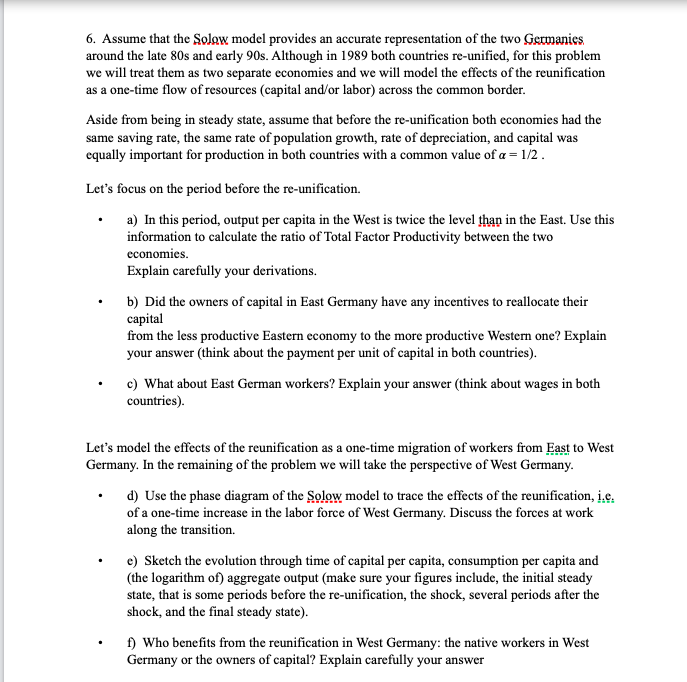I need help with Questions 6 & 7 only please. If you could help me with either id really appreciate it
6. Assume that the Solow model provides an accurate representation of the two Germanics around the late 80s and early 90s. Although in 1989 both countries re-unified, for this problem we will treat them as two separate economies and we will model the effects of the reunification as a one-time flow of resources (capital and/or labor) across the common border. Aside from being in steady state, assume that before the re-unification both economies had the same saving rate, the same rate of population growth, rate of depreciation, and capital was equally important for production in both countries with a common value of a = 1/2 . Let's focus on the period before the re-unification. a) In this period, output per capita in the West is twice the level than in the East. Use this information to calculate the ratio of Total Factor Productivity between the two economies. Explain carefully your derivations. b) Did the owners of capital in East Germany have any incentives to reallocate their capital from the less productive Eastern economy to the more productive Western one? Explain your answer (think about the payment per unit of capital in both countries). c) What about East German workers? Explain your answer (think about wages in both countries). Let's model the effects of the reunification as a one-time migration of workers from East to West Germany. In the remaining of the problem we will take the perspective of West Germany. d) Use the phase diagram of the Solow model to trace the effects of the reunification, i.e. of a one-time increase in the labor force of West Germany. Discuss the forces at work along the transition. e) Sketch the evolution through time of capital per capita, consumption per capita and (the logarithm of) aggregate output (make sure your figures include, the initial steady state, that is some periods before the re-unification, the shock, several periods after the shock, and the final steady state) f) Who benefits from the reunification in West Germany: the native workers in West Germany or the owners of capital? Explain carefully your answer7. The Solow model and the capital income share. a) Discuss the data and assumptions you need to measure the value of a in the production function. b) Assume an economy saves according to the following rule "(accounting) profits are always reinvested, wages consumed". Derive the savings rate in this economy. Find the steady state level of capital per capita for this economy. c) Discuss what is special about the steady state you characterized in b)








